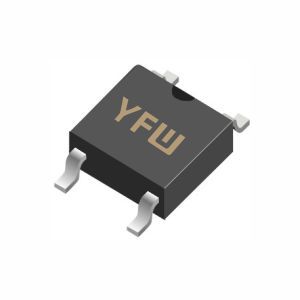Solving MOSFET Overheating Issues: Key Strategies for Optimal Performance
Date:2025-04-30 Categories:Product knowledge Hits:680 From:Guangdong Youfeng Microelectronics Co., Ltd

Switching LossesAt high switching frequencies, energy is dissipated during the transition between the off-state and on-state. Poor gate drive conditions (e.g., insufficient voltage, slow rise/fall times) prolong these transitions, escalating switching losses and heat.
Inadequate Thermal ManagementEven low-loss MOSFETs can overheat if heat isn’t efficiently dissipated. Insufficient heat sinking, poor PCB layout (e.g., inadequate copper planes for heat spreading), or high ambient temperatures hinder thermal dissipation.
Overloading or MisapplicationOperating a MOSFET beyond its rated voltage (Vds) or current (Id) ratings, or in circuits with inadequate protection (e.g., surge currents, voltage spikes), causes abnormal power dissipation and thermal runaway.
Optimize Device SelectionChoose MOSFETs with low Rds(on) for your target current range. YF Micro’s high-performance super-junction MOSFETs and low-voltage MOSFETs are engineered to minimize conduction losses, ideal for high-efficiency applications. For high-frequency systems, our ultra-fast switching MOSFETs reduce transition times, cutting switching losses significantly.
Improve Gate Drive DesignEnsure the gate driver provides adequate voltage (typically 10–15V for full enhancement) and fast edge rates. Use a gate resistor network to control rise/fall times without excessive oscillations. YF Micro’s application notes offer detailed guidance on matching drivers to specific MOSFET models.
Enhance Thermal Design
Heat Sinks and Thermal Pads: Select heat sinks with appropriate thermal resistance (Rth) and use high-conductivity thermal interface materials to bridge the MOSFET and sink.
PCB Layout: Maximize copper pour under the MOSFET, use thermal vias to conduct heat to inner layers, and ensure sufficient spacing for airflow in air-cooled systems.
Thermal Management ICs: Integrate temperature sensors or active cooling controls for critical applications.
Circuit Protection and Load MatchingIncorporate over-current/over-voltage protection (e.g., TVS diodes, fuses) to prevent overloads. Verify the MOSFET’s safe operating area (SOA) against actual operating conditions, especially in inductive loads where voltage spikes are common.
Thermal Characterization and TestingUse YF Micro’s comprehensive thermal data (e.g., junction-to-case thermal resistance, Rth(j-c)) during design. Validate prototypes with thermal imaging to identify hotspots and refine heat dissipation strategies.
At YF Micro, we combine innovative materials (such as trench and super-junction structures) and precision manufacturing to deliver MOSFETs with industry-leading thermal performance. Our products undergo rigorous testing to ensure low Rds(on), fast switching speeds, and robust SOA, minimizing inherent heat generation. Paired with our application support and thermal design expertise, we help customers achieve optimal efficiency and reliability in power conversion, motor control, and industrial systems.
MOSFET overheating can be effectively managed through a combination of proper device selection, optimized circuit design, and robust thermal management. By addressing conduction and switching losses while enhancing heat dissipation, engineers can unlock the full potential of these components. Trust YF Micro’s high-quality MOSFETs and technical support to overcome thermal challenges and build more efficient, durable systems.
For more insights or product inquiries, contact our technical team at
sales@yfwdiode.com or explore our full MOSFET portfolio
here.

Previous:
Classification, Structure, and Principle of MOSFET
Next:
Exploring CoolMOS: The Next-Generation Power MOSFET Technology
